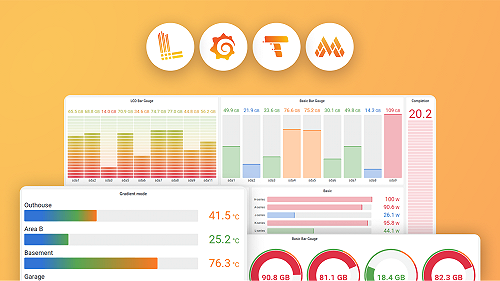Instrument a .NET application
The Grafana OpenTelemetry distribution for .NET provides a pre-configured and pre-packaged bundle of OpenTelemetry .NET components, optimized for Grafana Cloud Application Observability.
Recommended setup for Grafana Cloud
Grafana Labs recommends that you set up OpenTelemetry components, including instrumentation and an OpenTelemetry Collector distribution, using one of the Grafana Cloud setup guides.
These opinionated guides make it easy to get started. They include all the binaries, configuration, and connection parameters you need to set up OpenTelemetry for Grafana Cloud.
Before you begin
Ensure you have a .NET development environment and an application using .NET 6+ or .NET Framework version 4.6.2 or higher.
Install the SDK
Use either the command line or Visual Studio to install the package.
Command line:
Run the following command in your project folder:
dotnet add package Grafana.OpenTelemetryAdditionally, install the console exporter for local testing:
dotnet add package OpenTelemetry.Exporter.ConsoleVisual Studio:
Open your project in Visual Studio, search for, and install the Grafana.OpenTelemetry package.
Also install the OpenTelemetry.Exporter.Console package for local testing.
Instrument your application
Choose the code tab below that matches your environment and modify it for your application.
Warning
The
AddConsoleExportercalls in the sample are only for local testing. Remove these calls for production applications.
// .NET 6+ console
using OpenTelemetry;
using OpenTelemetry.Metrics;
using OpenTelemetry.Trace;
using Grafana.OpenTelemetry;
using var tracerProvider = Sdk.CreateTracerProviderBuilder()
.UseGrafana()
.AddConsoleExporter()
.Build();
using var meterProvider = Sdk.CreateMeterProviderBuilder()
.UseGrafana()
.AddConsoleExporter()
.Build();
using var loggerFactory = LoggerFactory.Create(builder =>
{
builder.AddOpenTelemetry(logging =>
{
logging.UseGrafana()
.AddConsoleExporter();
});
});Run your application
Run your application with the following command:
OTEL_RESOURCE_ATTRIBUTES="service.name=<name>,service.namespace=<namespace>,deployment.environment=<environment>" \
OTEL_EXPORTER_OTLP_ENDPOINT=<endpoint> \
OTEL_EXPORTER_OTLP_PROTOCOL="http/protobuf" \
dotnet runReplace variables in <...> with values specific to your application and backend. For more details, see the
OpenTelemetry service attributes documentation.
<name>: your service name, for example,shoppingcart<namespace>: a string to group related services, such asecommercefor a team that manages several services<environment>: the deployment environment, for example, theproductiondeployment tier
Some backends, such as Grafana Cloud, also require you to set authentication headers in the OTEL_EXPORTER_OTLP_HEADERS environment variable.
Test your instrumentation
To verify successful instrumentation, run your application, generate some traffic, and check that metrics and logs appear in the console.
Example metrics output:
Metric Name: process.cpu.count, The number of processors (CPU cores) available to the current process., Unit: {processors}, Meter: OpenTelemetry.Instrumentation.Process/0.5.0.3
(2024-06-05T02:14:47.6851243Z, 2024-06-05T02:14:57.7092810Z] LongSumNonMonotonic
Value: 12Example logs output:
LogRecord.Timestamp: 2024-06-05T02:14:47.9338272Z
LogRecord.CategoryName: Microsoft.Hosting.Lifetime
LogRecord.Severity: Info
LogRecord.SeverityText: Information
LogRecord.Body: Now listening on: {address}
LogRecord.Attributes (Key:Value):
address: http://localhost:5117
OriginalFormat (a.k.a Body): Now listening on: {address}
LogRecord.EventId: 14
LogRecord.EventName: ListeningOnAddressExample application
See the Rolldice service for a complete example setup.

